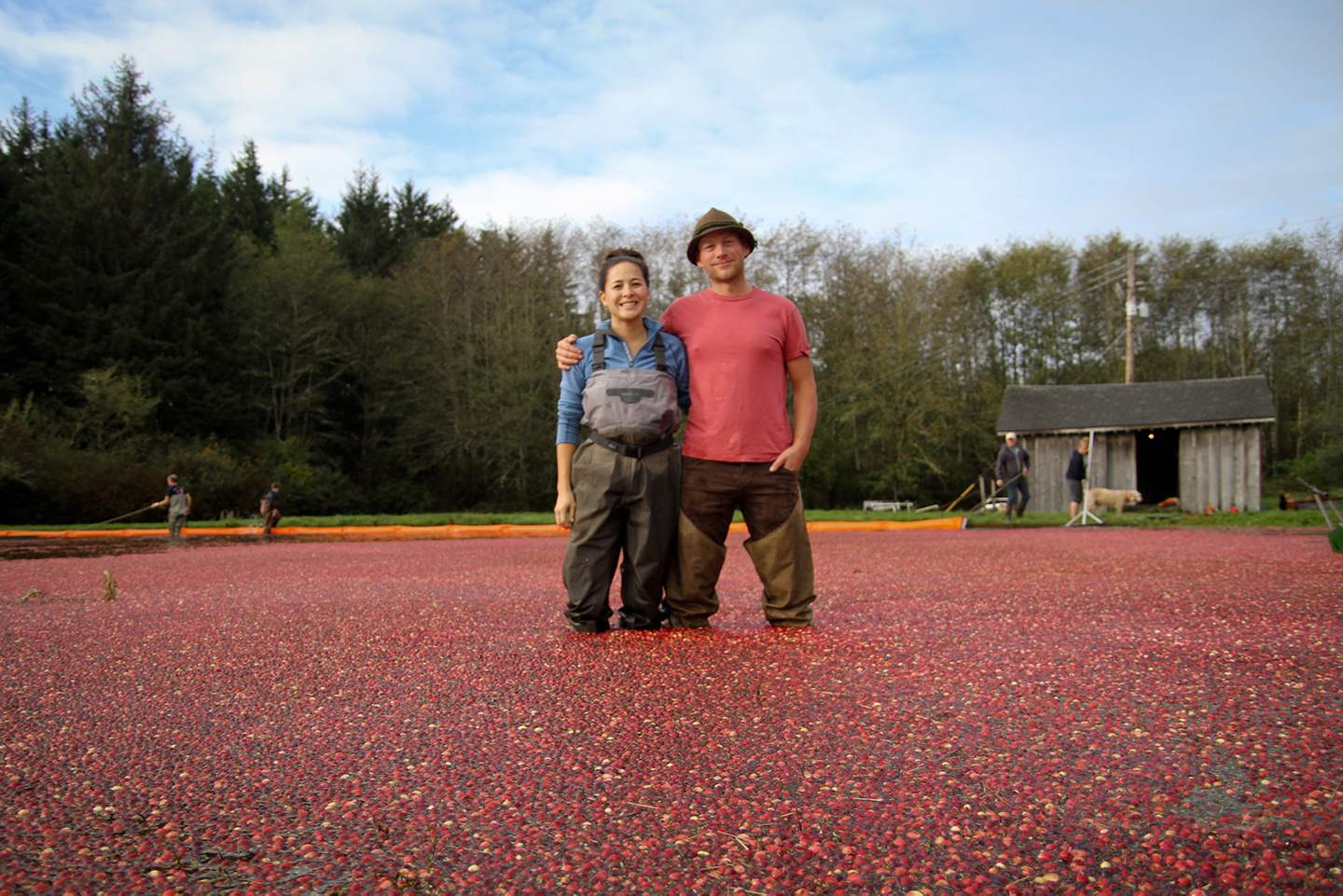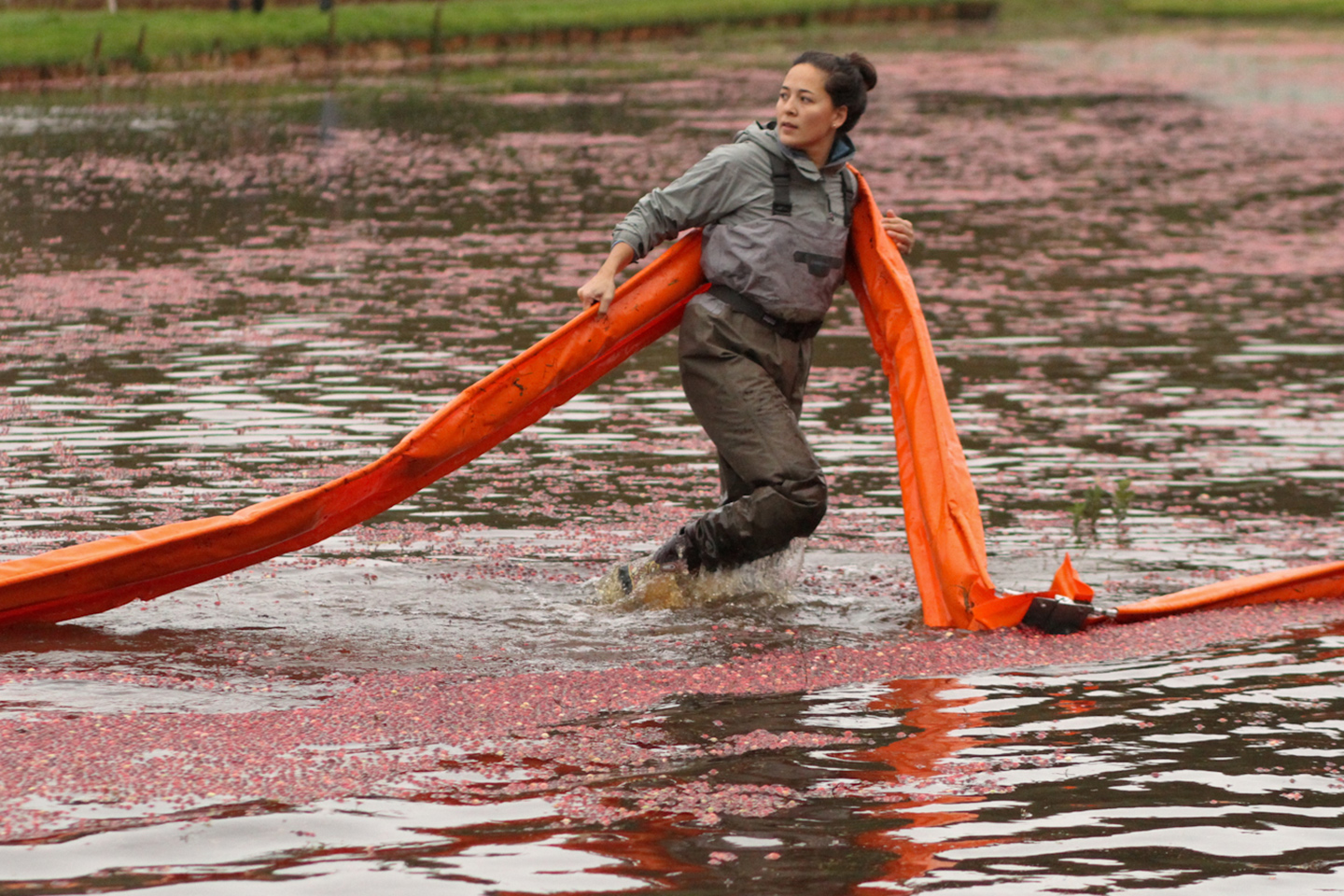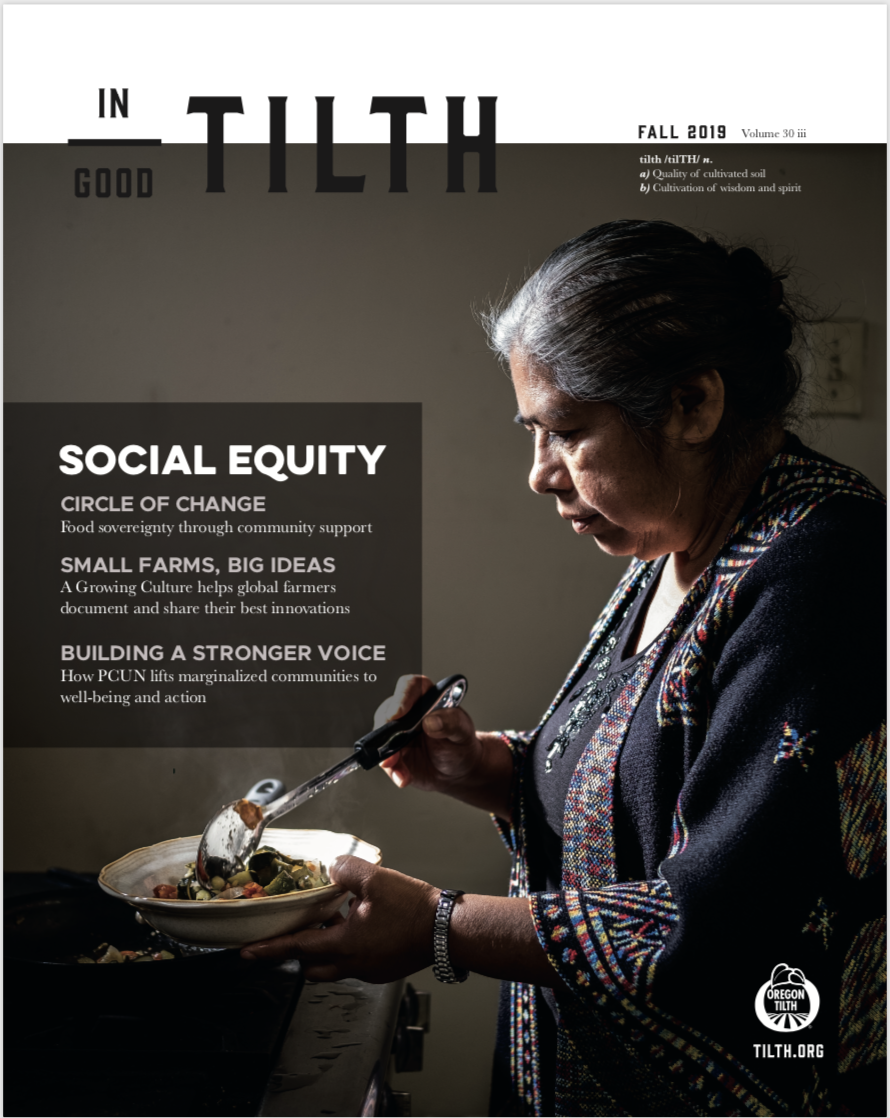A new pioneer spirit is taking hold in the cranberry bogs of the Pacific Northwest. A small cadre of cranberry growers are transitioning their farms to organic production, and figuring their way through a thicket of problems — from pest and weed management to fertilization regimes to building a market for their crop. As with many farmers venturing into organic production with a new crop or in a new region, they’re finding that there’s no how-to manual to deal with these issues. So these growers are building a fellowship of Pacific Northwest (PNW) organic cranberry farmers, leaning on one another for a helping hand, equipment, and — crucially — information hard-won from seasons of trial-and-error. By combining forces, they’re hoping to draw on a wider community of wholesalers, processors, certifiers and agronomists to forge an organic future for PNW cranberries.
It’s not easy being first
“The major challenge when we got into organic cranberry production was just that nobody had done it before,” said Jared Oakes, co-founder of Starvation Alley cranberry farm in Long Beach, Washington, the state’s first certified organic cranberry farm. “Or at least nobody had done it in our area to an extent that allowed them to show other people how to do it. We called all the major colleges and local experts, and all the farmers around here and what we heard, almost to a man, was: ‘You can’t do it. It’s not possible to grow organically.'”
At first glance, it might not seem like growing cranberries organically in the PNW would be that outlandish of a plan, since conventional cranberry production is already big business in the area. But conventional growers use synthetic herbicides, pesticides and fertilizers not permitted for organic operations, so their experience and advice can only help so much.

Oregon and Washington State University extension offices offer detailed information on cranberries, but these are all primarily geared towards conventional growers. Organic cranberry bogs are fairly well-established in places like Wisconsin and Quebec, but those regions have different soil and climate conditions and contend with a different group of pests and weeds, so even their organic practices are not completely transferable to growers in the PNW.
These seemingly small distinctions can be the difference between a healthy harvest and a cranberry bog overrun with willow and cut grass, or decimated by the blackheaded fireworm. When we hear about the challenges to growth for organic food, the stories are often about big-picture issues like subsidy systems and consumer appetites. We hear less about the nitty-gritty details of adapting integrated pest management plans or fertilization systems, which have to be figured out by each community of growers as they establish a new crop or region for organic production. But these are the very specific struggles that can make or break organic production in a region.
It is a pivotal time for PNW cranberry farmers. Many conventional cranberry farms in Oregon and Washington don’t have clear succession plans, as a wave of growers are reaching retirement age. The conventional cranberry market has seen major dysfunction in recent years, and many growers are unable to get decent prices for their harvest. The situation has gotten so dire that the USDA ordered cranberry handlers to withhold 15 percent of the 2017 crop from the market to stabilize prices. The price premium that comes with organic certification could offer a way forward, but organic cranberry bogs are currently plagued by crop losses to weeds and pests. The experience of pioneering organic cranberry growers can play a crucial role in working out these kinks in production and beating a trail forward for conventional farms that want to transition to organic. Facing stiff headwinds and reckoning with weeds and pests that nobody quite knew how to manage organically, these pioneering organic cranberry growers have banded together to support one another.
The growers willing to try organic farming in an untested crop and region tend to be newcomers, like Richard and Pam Schmidt, owners of Schmidt Berries in Bandon, Oregon, who bought their cranberry farm from family friends, the Vincents, two years ago, on its last year of transition to organic.

“It’s been a steep learning curve,” said Richard Schmidt. “We’ve really relied on our neighbor, Ty Vincent, and his dad, Bill Vincent. They were the ones that put the farm into transition after 30 plus years of traditional practice. It’s their expertise and practical experience that have made our new inexperienced farmer reality much easier. They are the essence of succession in a community. We’d never really been farmers before, and had never lived or farmed on the Oregon coast…we mainly rely on our neighbors. We’ll help them harvest, and they help us harvest. They’re organic too, so we can share equipment, which is kind of nice.”
Cassie Bouska at Oregon State University’s Coos County Extension Office has also been an invaluable resource for organic growers like Richard and Pam Schmidt on a one-to-one basis. “Cassie is so committed to helping cranberry farmers, and she does an exceptional job,” said Schmidt. “She’s very agreeable to come out to anybody and everybody’s farm and discuss problems, and then takes it back to her extension office and researches options to help us.”
But there are limits to the organic-specific knowledge researchers like Bouska can bring to the table. “She holds quarterly classes or meetings where we talk about pest and disease management,” said Schmidt, “but it’s mostly for traditional growers.” That’s why PNW organic cranberry farmers are organizing to share information with one another and to call in the organic-specific expert help
they need.
Callin in the cavalry
“We started thinking about gathering the stakeholders, and putting things on ourselves,” said Jared Oakes. “We’re trying to move the ball forward, and get momentum going for the organic sector for cranberry growing on the West Coast.”
Last year, Starvation Alley organized the first PNW organic cranberry growers meeting, and then handed the meeting off to Drew Katz at Oregon Tilth; the second annual meeting, organized by Katz, was held in March 2018 in Bandon, Oregon. These kinds of meetings allow organic cranberry growers to talk to one another about what works, and to use their combined heft to leverage some outside expertise and get the wider community to the table.
“If you’re having a conference every year it adds a little bit of energy and accountability” said Oakes. “For farmers, this is their livelihood, so they’re going to share information with each other either way. We all talk a few times a year at least, but it’s kind of in a silo. So having that conference is important…while there is demand for organic cranberries, it’s hard to access those markets. So it’s also about getting buyers in the room with growers, and then relationships can be made.”
Wholesalers and processors like Bob Wilson of the Cranberry Network were there to present the business side.

“For us, the most helpful thing was having Bob Wilson come with graphs and statistical information, being able to see the big picture lets us know about pricing and marketing for our product,” said Pam Schmidt. “There’s no point in farming for a living if you can’t sell your product, otherwise you’ll starve to death. Especially with organic farming, it’s so labor-intensive that you almost can’t work an outside job. The biggest thing for us was knowing what’s going on outside in the world and how that’s going to affect us, and the type of product we have to be producing.”
Sorely needed science
Aside from bringing buyers and sellers together, Jared Oakes hopes that community building among PNW organic cranberry growers will help get money flowing into the kind of long-term, large-scale research on pest and weed prevention that can get production onto a more financially sustainable track. This research, which only well-funded professional research agronomists can provide, is needed to build out a rigorous, empirically validated how-to manual for organic cranberry growing in the PNW.
“My hope is that the next step is working out techniques and application studies that only a university has the ability and knowledge to do,” said Oakes. “I don’t see them doing that yet, so I hope they’re funding some of those research ideas, multi-year studies rather than one-off, one-person resource to help specific farmers. Right now, for a farmer who wants to know ‘What do I do when X happens?’ There’s still a lot of, ‘I don’t know, you should ask other farmers.’”
Researchers like Cassie Bouska at Oregon State University extension agree.
“There is a lot of work I’d like to do with regard to organic cranberry production, but I’m the only one down here anymore, so there’s a capacity problem,” said Bouska. “As for the biggest gaps in knowledge that we have, I think we need to reframe how we think about pest thresholds in organic systems. But in order to do that with any degree of confidence — and you need confidence for this; these growers are operating on slim margins, if not deficits — you need data. And we just don’t have it. Nor do we have the capacity to generate it at the moment.”
It is not only PNW cranberries that are suffering from a lack of research dollars. Across the country, farmers transitioning to organic and designing integrated pest management systems are finding a dearth of empirical evidence about what works and what doesn’t. The USDA’s Organic Agriculture Research and Extension Initiative (OREI) funds this exact sort of region- and crop-specific research, but funding has not kept pace as the organic agriculture sector has exploded in recent years. Senator Susan Collins and others have proposed increasing OREI’s funding from $20 million to $50 million per year as part of the 2018 Farm Bill. This increase in funding is crucial for organic farmers such as Jared Oakes, who are trying to establish an organic crop in a new region.

colleagues on harvest day at Starvation Alley cranberry farm. Photo by Madeline Moore
A crucial moment
As organic farming grows around the world, we hear about fights over regulations and subsidy systems in halls of power. Cultures of consumption are debated in newspapers and over dinner tables around the country. These high-level changes in culture and politics are critical to the expansion of organic agriculture, but they are only part of the story. Just as important are the struggles taking place at a local level, where organic growers are figuring out how to control weeds and pests, and struggling to make the numbers add up. Each crop grown in each region requires local expertise, built up by communities of growers through trial and error, and through the sharing of information with one another. It also requires a vibrant community around the growers, of processors, wholesalers, certifiers, and crucially, agronomists.
“We can become a significant supplier of organic cranberries,” said Oakes. “But before we step into that moment, we need some significant research dollars and expertise to make that not just something crazy entrepreneurs are trying, but something that a farmer weighing risk would, and we need to show them the pathway to do that. That can help our climate, our water, the health of our communities —in so many ways it’s a positive.”



















